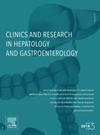液滴数字PCR技术对慢性hbv感染者血液中共价闭合环状DNA的定量检测具有超灵敏的效果。
IF 2.4
4区 医学
Q2 GASTROENTEROLOGY & HEPATOLOGY
Clinics and research in hepatology and gastroenterology
Pub Date : 2025-01-18
DOI:10.1016/j.clinre.2025.102531
引用次数: 0
摘要
背景:共价闭合环状DNA (cccDNA)是一种稳定的,外源形式的HBV DNA。cccDNA是控制CHB感染中肝内事件的真正标志物。定量cccDNA对于监测疾病进展和抗病毒治疗的疗效至关重要。方法:为规范方法,从HepAD38细胞中分离HBV总DNA,用三种核酸外切酶酶切去除线性和松弛的环状HBV DNA。用特定引物ddPCR对cccDNA进行纯化定量。将HBV DNA和HBsAg均可检测的初治慢性乙型肝炎患者(nCHBV, n=36)按HBsAg水平分为I组(HBsAglo < 2000 IU/ml, n=11)和II组(HBsAghi > 2000 IU/ml, n=25)。测定血浆cccDNA、HBV DNA和HBsAg含量,并比较各组间差异。将其与临床/组织病理学特征进行对比。结果:未消化的3.6 ^10⁶et-ve HepAD38细胞显示316拷贝/µl的总病毒DNA。用三酶消化线性、整合和松弛的环状DNA后,检测到15拷贝/µl的cccDNA。同样,DNA消化后,HBsAglo患者的中位数为8.5拷贝/µl (IQR为2.75-9.75拷贝/µl), HBsAghi患者的中位数为11拷贝/µl (IQR为4-16拷贝/µl),但组间差异无统计学意义(p=0.093)。此外,cccDNA拷贝数低的HBsAglo患者的纤维化等级明显高于HBsAghi患者(p=0.036)。结论:我们得出结论,采用三种外切酶、cccDNA特异性引物和ddPCR的联合方法,即使在HBsAg和HBV DNA水平低的患者中也能检测到cccDNA拷贝。这种综合方法作为替代诊断工具提供了额外的验证。本文章由计算机程序翻译,如有差异,请以英文原文为准。

Droplet digital PCR technique is ultrasensitive for the quantification of covalently closed circular DNA in the blood of chronic HBV-infected patients
Background
Covalently closed circular DNA (cccDNA) is a stable, episomal form of HBV DNA. cccDNA is a true marker for the intrahepatic events in controlled CHB infection. Quantifying cccDNA is critical for monitoring disease progression, and efficacy of anti-viral therapies.
Methods
To standardize the method, total HBV DNA was isolated from HepAD38 cells and digested with three exonuclease enzymes to remove linear and relaxed circular HBV DNA. Purified cccDNA quantification used ddPCR with specific primers. Treatment-naive chronic hepatitis B virus patients (nCHBV, n=36) with detectable HBV DNA and HBsAg were grouped by HBsAg levels: Group I (HBsAglo < 2000 IU/ml, n=11) and Group II (HBsAghi > 2000 IU/ml, n=25). cccDNA, HBV DNA and HBsAg were quantified in plasma and compared between groups. Correlation with clinical/histopathological features was done.
Results
Non-digested 3.6^10⁶ tet-ve HepAD38 cells showed 316 copies/µl of total viral DNA. After digesting the linear, integrated, and relaxed circular DNA with triple enzymes, 15 copies/µl of cccDNA were detected. Similarly, after DNA digestion, HBsAglo patients showed a median of 8.5 copies/µl (IQR 2.75-9.75 copies/µl), and HBsAghi gave a median of 11 copies/µl (IQR 4-16 copies/µl) but with no significant difference between groups (p=0.093). Further, HBsAglo patients with low cccDNA copy numbers showed significantly higher fibrosis grades than HBsAghi (p=0.036).
Conclusions
We conclude that employing a combined approach utilizing three exonucleases, cccDNA-specific primers, and ddPCR enables the detection of cccDNA copies even in patients exhibiting low levels of HBsAg and HBV DNA. This integrated method offers additional validation as a surrogate diagnostic tool.
求助全文
通过发布文献求助,成功后即可免费获取论文全文。
去求助
来源期刊

Clinics and research in hepatology and gastroenterology
GASTROENTEROLOGY & HEPATOLOGY-
CiteScore
4.30
自引率
3.70%
发文量
198
审稿时长
42 days
期刊介绍:
Clinics and Research in Hepatology and Gastroenterology publishes high-quality original research papers in the field of hepatology and gastroenterology. The editors put the accent on rapid communication of new research and clinical developments and so called "hot topic" issues. Following a clear Editorial line, besides original articles and case reports, each issue features editorials, commentaries and reviews. The journal encourages research and discussion between all those involved in the specialty on an international level. All articles are peer reviewed by international experts, the articles in press are online and indexed in the international databases (Current Contents, Pubmed, Scopus, Science Direct).
Clinics and Research in Hepatology and Gastroenterology is a subscription journal (with optional open access), which allows you to publish your research without any cost to you (unless you proactively chose the open access option). Your article will be available to all researchers around the globe whose institution has a subscription to the journal.
 求助内容:
求助内容: 应助结果提醒方式:
应助结果提醒方式:


